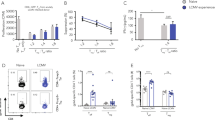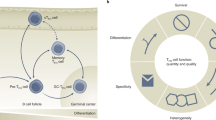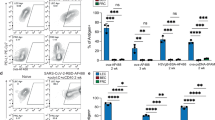Abstract
We assessed the potential for an allogeneic-based vaccine against HIV infection in women who were allo-immunized with their partners' mononuclear leucocytes to prevent spontaneous recurrent abortion. Within 1 month of allo-immunization, there was significant upregulation in the concentrations of CD8 cell-derived suppressor factor activity, RANTES, and macrophage inflammatory proteins 1α and 1β. Allo-immunization also downregulated the proportion of cells with CCR5 and CXCR4 receptors. We also found a dose-dependent decrease in HIV infectivity of CD4+ cells in vitro after allo-immunization with both primary and T-cell line adapted HIV-1. This study provides a rational basis for an alternative or complementary strategy of allo-immunization against HIV infection.
This is a preview of subscription content, access via your institution
Access options
Subscribe to this journal
Receive 12 print issues and online access
$209.00 per year
only $17.42 per issue
Buy this article
- Purchase on Springer Link
- Instant access to full article PDF
Prices may be subject to local taxes which are calculated during checkout





Similar content being viewed by others
References
Mackewicz, C. & Levy, J.A. CD8+ cell anti-HIV activity: Nonlytic suppression of virus replication. AIDS Res. Hum. Retro. 8, 629–640 (1992).
Cocchi, F. et al. Identification of RANTES, MIP-1α and MIP-1β as the major HIV-suppressive factors produced by CD8+ T cells. Science 270, 1811–1815 (1995).
Lehner, T. et al. Protective mucosal immunity elicited by targeted iliac lymph node immunization with a subunit SIV envelope and core vaccine in macaques. Nature Med. 2, 767–775 (1996).
Heeney, J. et al. β-chemokines and neutralizing antibody titers correlate with sterilizing immunity generated in HIV vaccinated macaques. Proc. Natl. Acad. Sci. USA 95, 10803–10808 (1998).
Desrosiers, R.C. et al. Vaccine protection against simian immunodeficiency virus infection. Proc. Natl. Acad. Sci. USA 8, 6353–6357 (1989).
Murphey-Corb, M. et al. Inactivated whole SIV vaccine confers protection in macaques. Science 246, 1293–1247 (1989).
Carlson, J.R. et al. Vaccine protection of rhesus macaques against simian immunodeficiency virus infection. AIDS Res. Hum. Retroviruses 336, 1239–1246 (1990).
Stott, E.J. et al. Preliminary report: protection of cynomolgus macaques against simian immunodeficiency virus by whole fixed cell vaccine. Lancet 336, 1538–1541 (1990).
Langlois, A.J., Weinhold, K.J., Matthews, T.J., Greenberg, M.L. & Bolognes, D.P. The ability of certain SIV vaccines to provoke reactions against normal cells. Science 255, 292–293 (1992).
Arthur, L.O. et al. Cellular proteins bound to immunodeficiency viruses: implications for pathogenesis and vaccines. Science 258, 1935–1938 (1992).
Stott, E.J. et al. Anti-cell antibody in macaques. Nature 353, 393 (1991).
Stott J. et al. Protection against simian immunodeficiency virus infection of macaques by cellular or viral antigens. Neuvieme Colloque des Cent Gardes 1994, 219–224 (1994).
Wang, Y. et al. Generation of CD8-SF and β-chemokines, induced by xenogeneic immunization, in the prevention of SIV infection in macaques. Proc. Natl. Acad. Sci. USA 95, 5223–5228 (1998).
Shearer, G.M., Clerici, M. & Dalgleish, A. Alloimmunization as an AIDS vaccine? Science 262, 161–162 (1993).
Clerici, M. et al. Alloactivated cytotoxic T cells recognize the carboxy-terminal domain of human immunodeficiency virus-1 gp120 envelope glycoprotein. Eur. J. Immunol. 23, 2022–2025 (1993).
Bruhl, P., Kerschbaum, A., Zimmermann, K., Eibl, M.M. & Mannhalter, J.W. Allostimulated lymphocytes inhibit replication of HIV type 1. AIDS Res. Hum. Retroviruses 12, 31–37 (1996).
Mowbray, J.F., Underwood, J.L., Michel, M., Forbes, P.B. & Beard, R.W. Immunization with paternal lymphocytes in women with recurrent miscarriage. Lancet ii, 679–680 (1987).
Bunce, M., Barnardo, M.C., Procter, J., Marsh, S.G., Vilches, C. & Welsh, K.I. High resolution HLA-C typing by PCR-SSP: identification of allelic frequencies and linkage disequilibria in 604 unrelated random UK Caucasoids and a comparison with serology. Tissue Antigens 50, 100–111 (1997).
Kishore, R., Agarrwal, S., Halder, A., Das, V., Shukla, B.R. & Agarwal, S.S. HLA sharing, anti-paternal cytotoxic antibodies and MLR blocking factors in women with recurrent spontaneous abortion. J. Obstet. Gynaecol. Res. 22, 177–183 (1996).
Cocchi, F., DeVico, A.L., Garzino-Demo, A., Cara, A., Gallo, R.C. & Lusso, P. The V3 domain of the HIV gp120 envelope glycoprotein is critical for chemokine- mediated blockade of infection. Nature Med. 2, 1244–1247 (1996).
Dragic, T. et al. HIV-1 entry into CD4+ cells is mediated by the chemokine receptor CC-CKR-5. Nature 381, 667–673 (1996).
Deng, H. et al. Identification of a major co-receptor for primary isolates of HIV-1. Nature 381, 661–666 (1996).
Feng, Y., Broder, C.C., Kennedy, P.E. & Berger, E.A. HIV-1 entry cofactor: functional cDNA cloning of a seven-transmembrane, G protein-coupled receptor. Science 272, 872–877 (1996).
Dean, M. et al. Genetic restriction of HIV infection and progression to AIDS by a deletion allele of the CKR5 structual gene. Science 273, 1856–1862 (1996).
Liu, R. et al. Homozygous defect in HIV-1 co-receptor accounts for resistance of some multiply-exposed individuals to HIV infection. Cell 86, 367–377 (1996).
Samson, M. et al. Resistance to HIV-1 infection in caucasian individuals bearing mutant alleles of the CCR-5 chemokine receptor gene. Nature 382, 722–725 (1996).
Amara, A. et al. HIV coreceptor downregulation as antiviral principle: SDF-1α-dependent internalization of the chemokine receptor CXCR4 contributes to inhibition of HIV replication. J. Exp. Med. 186, 139–146 (1997).
Wu, J. et al. CCR5 levels and expression pattern correlate with infectability by macrophage-tropic HIV-1, in vitro. J. Exp. Med. 186, 1681–1691 (1997).
Simmons, G. et al. Primary, syncytium-inducing human immunodeficiency virus type 1 isolates are dual-tropic and most can use either Lestr or CCR5 as coreceptors for virus entry. J. Virol. 70, 8355–8360 (1996).
Paxton, W. et al. Relative resistant to HIV-1 infection of CD4 lymphocytes from persons who remain uninfected despite multiple high-risk sexual exposures. Nature Med. 2, 412–417 (1996).
Pinto, L.A., Sharpe, S., Cohen, D.I. & Shearer, G.M. Alloantigen-stimulated anti-HIV activity. Blood 92, 3346–3354 (1998).
Moriuchi, H., Moriuchi, M. & Fauci, A.S. Induction of HIV-1 replication by allogeneic stimulation. J. Immunol. 162, 7543–7548 (1999).
Tachibana K. et al. The chemokine receptor CXCR4 is essential for vascularization of the gastrointestinal tract. Nature 393, 591–594 (1998).
Zhou, Y., Kottmann, A.H., Kuroda, M., Taniuchi, I. & Littman D.R. Function of the chemokine receptor CXCR4 in haematopoiesis and in cerebellar development. Nature 393, 595–599 (1998).
Plummer,F.A. et al. Evidence of resistance to HIV among continuously exposed prostitutes in Nairobi, Kenya. >Program and Abstracts: IXth Int. Conf. AIDS/HIV STD World Congress Abstract WS, A07-3 (Berlin, 1993).
Celum, C.L. et al. Risk factors for repeatedly reactive HLA-1 EIA and indeterminate western blot. A population-based case-control study. Arch. Intern. Med. 154, 1129–1137 (1994).
Kind, C. Mother-to-child transmission of human immunodeficiency virus type 1: influence of parity and mode of delivery. Eur. J. Pediatr. 154, 542–545 (1995).
Acknowledgements
This work was supported partly by grants from the European Community Concerted Action Against AIDS (CT 960450), the National Institute of Acquired Immunodeficiency Disease, Washington, DC, and Guy's Special Trustees.
Author information
Authors and Affiliations
Corresponding author
Rights and permissions
About this article
Cite this article
Wang, Y., Tao, L., Mitchell, E. et al. Allo-immunization elicits CD8+ T cell-derived chemokines, HIV suppressor factors and resistance to HIV infection in women. Nat Med 5, 1004–1009 (1999). https://doi.org/10.1038/12440
Received:
Accepted:
Issue Date:
DOI: https://doi.org/10.1038/12440
This article is cited by
-
HLA-mismatched allogeneic adoptive immune therapy in severely immunosuppressed AIDS patients
Signal Transduction and Targeted Therapy (2021)
-
Control of HIV-1 infection by soluble factors of the immune response
Nature Reviews Microbiology (2004)



